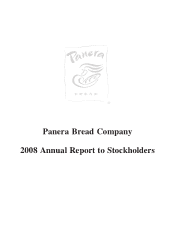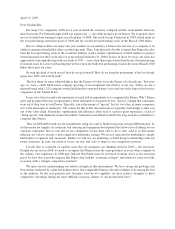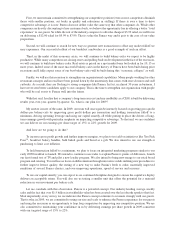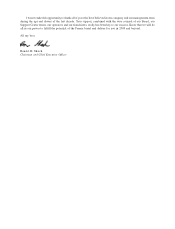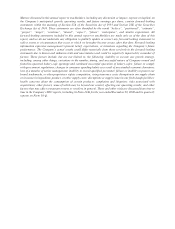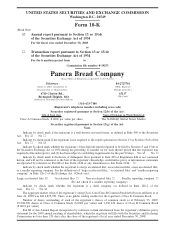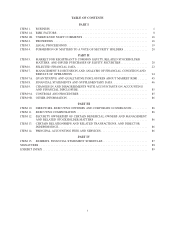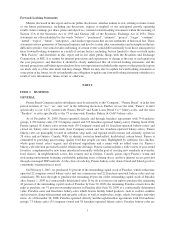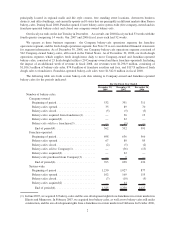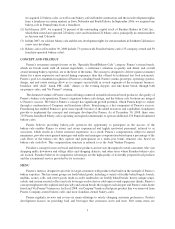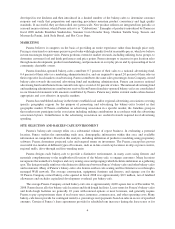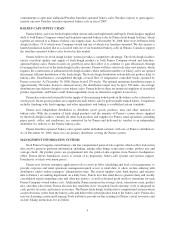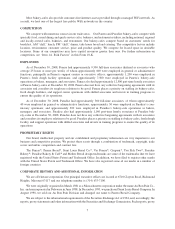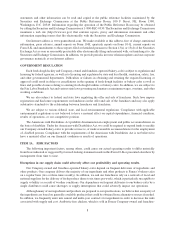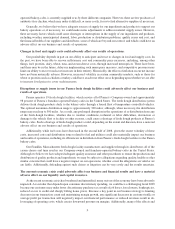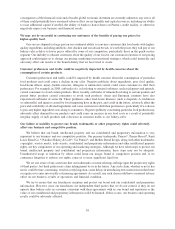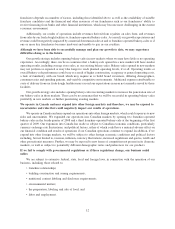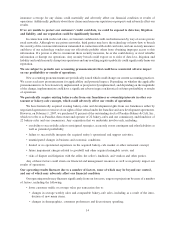Panera Bread 2008 Annual Report Download - page 11
Download and view the complete annual report
Please find page 11 of the 2008 Panera Bread annual report below. You can navigate through the pages in the report by either clicking on the pages listed below, or by using the keyword search tool below to find specific information within the annual report.developed in test kitchens and then introduced in a limited number of the bakery-cafes to determine customer
response and verify that preparation and operating procedures maintain product consistency and high quality
standards. If successful, they are then rolled out system-wide. New product rollouts are integrated into periodic or
seasonal menu rotations, which Panera refers to as “Celebrations.” Examples of products introduced by Panera in
fiscal 2008 include Breakfast Sandwiches, Summer Corn Chowder Soup, Chicken Tortilla Soup, Tomato and
Mozzarella Panini, Irish Soda Bread, and Hot Cross Buns.
MARKETING
Panera believes it competes on the basis of providing an entire experience rather than through price only.
Pricing is structured so customers perceive good value with high quality food at reasonable prices, which we believe
in turn encourages frequent visits. Panera performs extensive market research, including utilizing focus groups, to
determine customer food and drink preferences and price points. Panera attempts to increase its per location sales
through menu development, product merchandising, and promotions at everyday prices and by sponsorship of local
community charitable events.
Panera franchise-operated bakery-cafes contribute 0.7 percent of their sales to a national advertising fund,
0.4 percent of their sales as a marketing administration fee, and are required to spend 2.0 percent of their sales in
their respective local markets on advertising. Panera contributes the same sales percentages from Company-owned
bakery-cafes towards the national advertising fund and marketing administration. Panera can increase national
advertising fund contributions from current levels up to a total of 2.6 percent of sales. The national advertising fund
and marketing administration contributions received from Panera franchise-operated bakery-cafes are consolidated
in our financial statements with amounts contributed by Panera. Panera may utilize external media when deemed
appropriate and cost effective in specific markets.
Panera has established and may in the future establish local and/or regional advertising associations covering
specific geographic regions for the purpose of promoting and advertising the bakery-cafes located in that
geographic market. If Panera establishes an advertising association in a specific market, the franchise group in
that market must participate in the association including making contributions in accordance with the advertising
association bylaws. Contributions to the advertising association are credited towards required local advertising
spending.
SITE SELECTION AND BAKERY-CAFE ENVIRONMENT
Panera’s bakery-cafe concept relies on a substantial volume of repeat business. In evaluating a potential
location, Panera studies the surrounding trade area, demographic information within that area, and available
information on competitors. Based on this analysis, including utilization of predictive modeling using proprietary
software, Panera determines projected sales and targeted return on investment. The Panera concept has proven
successful in a number of different types of locations, such as in-line or end-cap locations in strip or power centers,
regional malls, drive-through and free-standing units.
Panera designs each bakery-cafe to provide a distinctive environment, in many cases using fixtures and
materials complementary to the neighborhood location of the bakery-cafe, to engage customers. Many locations
incorporate the warmth of a fireplace and cozy seating areas and groupings which facilitate utilization as a gathering
spot. The design visually reinforces the distinctive difference between Panera’s bakery-cafes and other bakery-cafes
and restaurants. Many of Panera’s bakery-cafes also feature outdoor cafe seating and free Internet access through a
managed WiFi network. The average construction, equipment, furniture and fixtures, and signage cost for the
30 Panera Company-owned bakery-cafes opened in fiscal 2008 was approximately $0.9 million, net of landlord
allowances and excludes capitalized development overhead, per bakery-cafe.
The average Panera Company-owned bakery-cafe size is approximately 4,600 square feet as of December 30,
2008. Panera leases all of its bakery-cafe locations and fresh dough facilities. Lease terms for Panera’s bakery-cafes
and fresh dough facilities are generally 10 years with renewal options at most locations, and generally require
Panera to pay a proportionate share of real estate taxes, insurance, common area, and other operating costs. Many
bakery-cafe leases provide for contingent rental (i.e. percentage rent) payments based on sales in excess of specified
amounts. Certain of Panera’s lease agreements provide for scheduled rent increases during the lease terms or for
4

